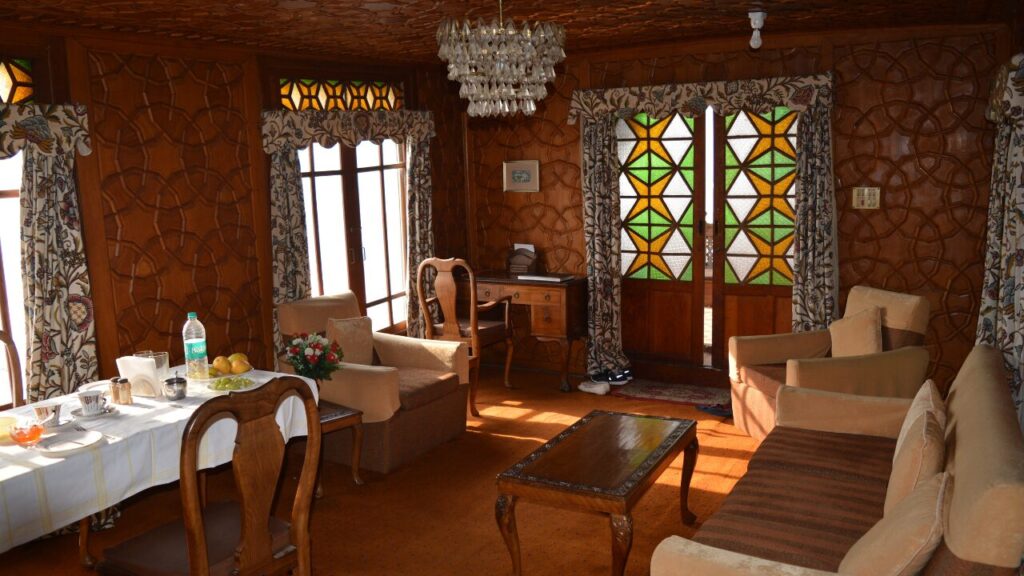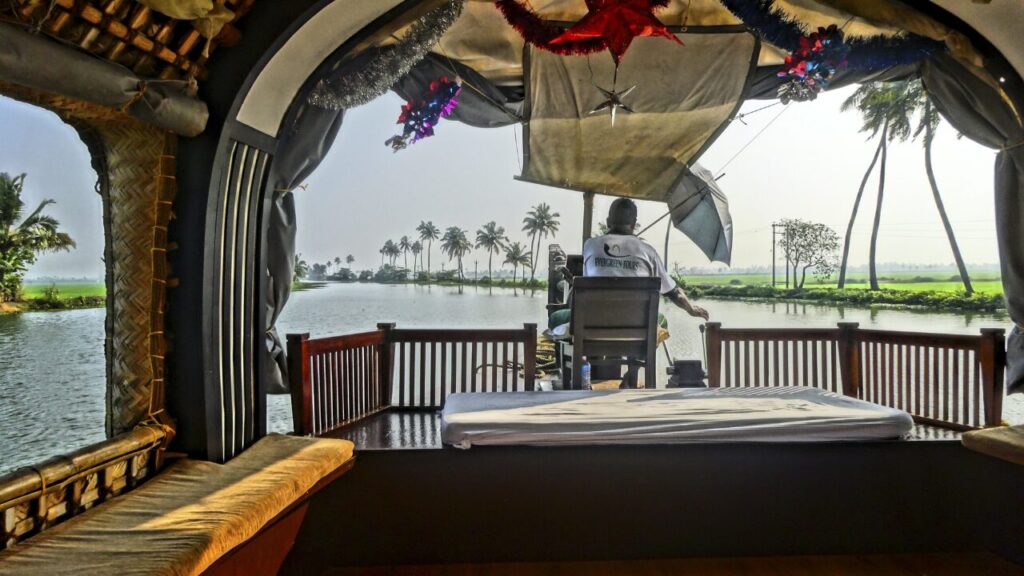The best way to explore the northern part of India “Srinagar” & the southern part of India “Kerala” is by Houseboat, but for both destinations the houseboat style & architecture are different.
The origin of Srinagar’s houseboats dates back to the late 19th century. The Kashmiri King Sri Gulab Singh had forbidden the British from buying land or building in the valley. The Hanji boatmen community of Srinagar found a roundabout way to accommodate English visitors and residents: they built houseboats!
The best way to explore the fascinating landscape of Kerala ‘Alleppey’, in southern India, is a floating house. The ancient Kettuvallams, iron transport boats, have been converted into luxury hotel rooms, and in them, one can discover, as in any other site, the shadowy remains of Kerala.
The floating houses of Srinagar, better known as Houseboats on Dal Lake in Srinagar, are about a thousand and unlike the floating houses of Kerala, the floating houses on Dal Lake are generally fixed.
Made of wood and with finely carved wooden panels, the floating houses are of different sizes, some even have three bedrooms, a living room and a kitchen.

The first floating houses were built in 1888 by the English. An ancient local law has “always” if foreigners are not allowed to build and own homes on Kashmiri soil. The loyal subjects of Queen Victoria were thus forced to invent the formula of building homes on the water if they wanted to stay in Srinagar in their own home. Today on Dal Lake there are about a thousand of these floating houses – the typology is recurrent, the cedar wood vessels, firmly anchored, are about twenty meters long and about four meters wide. They have a walkable veranda with inlaid bulkheads that leads to a living room and a corridor onto which the kitchen opens and, at the end, 2-3 bedrooms with bathrooms. They often have strange names and the houses on the water are reserved for tourists with various formulas from pure and simple rental to full board with a butler on board to the one closest to the hotel tout court.
Staying on a houseboat offers a unique experience.
Have you ever taken a houseboat cruise on the Kerala backwaters? If not, then make sure you do. It is truly a wonderful and unforgettable experience!
Today, houseboats are large, exotic, slow-moving pleasure boats that are actually revamped versions of the kettuvallams of the old days. The original kettuvallams were used to transport tons of rice and spices. A standard kettuvallam can carry up to 30 tons from Kuttanad to the Kochi port.
The kettuvallam is held together with knots of coconut fiber. Not a single nail is used in the construction of the boat. The boat is made of breadfruit planks, held together with coconut fiber. It is then coated with a black resin obtained by boiling cashew nuts. With proper care, a kettuvallam can last for generations.

A section of the kettuvallam was covered with bamboo and coconut fibre, and served as a toilet and kitchen for the crew. Meals were prepared on the boat and supplemented with fresh fish from the backwaters, cooked on board.
When modern trucks replaced this mode of transport, someone found a way to keep these boats, almost all over a hundred years old, on the market. By building special rooms to accommodate travellers, these boats have sailed from near extinction as entertainment to their current great popularity.
They are now a familiar sight on the backwaters and in Alappuzha alone there are up to 500 houseboats.
While converting the kettuvallams into houseboats, great care is taken in choosing natural products. Bamboo mats, sticks and betel wood for the roofing, coconut fibre mats and wooden planks for the floor, and coconut wood and coconut fibre for the beds. For lighting, however, solar panels have been used.
Today, houseboats have all the comforts of a good hotel, including furnished bedrooms, modern bathrooms, comfortable living rooms, kitchens and even a balcony for fishing. Part of the curved roof, made of wood or woven palm leaves, extends to provide a view of everything in the shade. Most boats are rowed by local oarsmen, but some are powered by a 40-horsepower engine. Train boats consist of two or more houseboats strung together and are used for larger groups of tourists.
What is it? The real magic of a houseboat trip is the breathtaking, unspoiled and otherwise inaccessible views of rural Kerala that are offered as you bob on the water! Isn’t that wonderful?
Srinagar houseboat are not moving houseboat even Kerala “Alleppey” houseboat are sailing houseboat. Srinagar houseboats stand one place in Dal Lake & Nagina Lake, even Alleppey Houseboat are covering a long distance. Srinagar Houseboat make by Cedar wood & walnut wood. Kerala Houseboat make by Bamboo, coir & normal woods. So, both houseboat are different style, architecture and material etc.
The best way to explore the northern part of India “Srinagar” & the southern part of India “Kerala” is by Houseboat, but for both destinations the houseboat style & architecture are different.
The origin of Srinagar’s houseboats dates back to the late 19th century. The Kashmiri King Sri Gulab Singh had forbidden the British from buying land or building in the valley. The Hanji boatmen community of Srinagar found a roundabout way to accommodate English visitors and residents: they built houseboats!
The best way to explore the fascinating landscape of Kerala ‘Alleppey’, in southern India, is a floating house. The ancient Kettuvallams, iron transport boats, have been converted into luxury hotel rooms, and in them, one can discover, as in any other site, the shadowy remains of Kerala.
The floating houses of Srinagar, better known as Houseboats on Dal Lake in Srinagar, are about a thousand and unlike the floating houses of Kerala, the floating houses on Dal Lake are generally fixed.
Made of wood and with finely carved wooden panels, the floating houses are of different sizes, some even have three bedrooms, a living room and a kitchen.

The first floating houses were built in 1888 by the English. An ancient local law has “always” if foreigners are not allowed to build and own homes on Kashmiri soil. The loyal subjects of Queen Victoria were thus forced to invent the formula of building homes on the water if they wanted to stay in Srinagar in their own home. Today on Dal Lake there are about a thousand of these floating houses – the typology is recurrent, the cedar wood vessels, firmly anchored, are about twenty meters long and about four meters wide. They have a walkable veranda with inlaid bulkheads that leads to a living room and a corridor onto which the kitchen opens and, at the end, 2-3 bedrooms with bathrooms. They often have strange names and the houses on the water are reserved for tourists with various formulas from pure and simple rental to full board with a butler on board to the one closest to the hotel tout court.
Staying on a houseboat offers a unique experience.
Have you ever taken a houseboat cruise on the Kerala backwaters? If not, then make sure you do. It is truly a wonderful and unforgettable experience!
Today, houseboats are large, exotic, slow-moving pleasure boats that are actually revamped versions of the kettuvallams of the old days. The original kettuvallams were used to transport tons of rice and spices. A standard kettuvallam can carry up to 30 tons from Kuttanad to the Kochi port.
The kettuvallam is held together with knots of coconut fiber. Not a single nail is used in the construction of the boat. The boat is made of breadfruit planks, held together with coconut fiber. It is then coated with a black resin obtained by boiling cashew nuts. With proper care, a kettuvallam can last for generations.

A section of the kettuvallam was covered with bamboo and coconut fibre, and served as a toilet and kitchen for the crew. Meals were prepared on the boat and supplemented with fresh fish from the backwaters, cooked on board.
When modern trucks replaced this mode of transport, someone found a way to keep these boats, almost all over a hundred years old, on the market. By building special rooms to accommodate travellers, these boats have sailed from near extinction as entertainment to their current great popularity.
They are now a familiar sight on the backwaters and in Alappuzha alone there are up to 500 houseboats.
While converting the kettuvallams into houseboats, great care is taken in choosing natural products. Bamboo mats, sticks and betel wood for the roofing, coconut fibre mats and wooden planks for the floor, and coconut wood and coconut fibre for the beds. For lighting, however, solar panels have been used.
Today, houseboats have all the comforts of a good hotel, including furnished bedrooms, modern bathrooms, comfortable living rooms, kitchens and even a balcony for fishing. Part of the curved roof, made of wood or woven palm leaves, extends to provide a view of everything in the shade. Most boats are rowed by local oarsmen, but some are powered by a 40-horsepower engine. Train boats consist of two or more houseboats strung together and are used for larger groups of tourists.
What is it? The real magic of a houseboat trip is the breathtaking, unspoiled and otherwise inaccessible views of rural Kerala that are offered as you bob on the water! Isn’t that wonderful?
Srinagar houseboat are not moving houseboat even Kerala “Alleppey” houseboat are sailing houseboat. Srinagar houseboats stand one place in Dal Lake & Nagina Lake, even Alleppey Houseboat are covering a long distance. Srinagar Houseboat make by Cedar wood & walnut wood. Kerala Houseboat make by Bamboo, coir & normal woods. So, both houseboat are different style, architecture and material etc.
Copyright © 2025 Delighted Journey | All Rights Reserved.